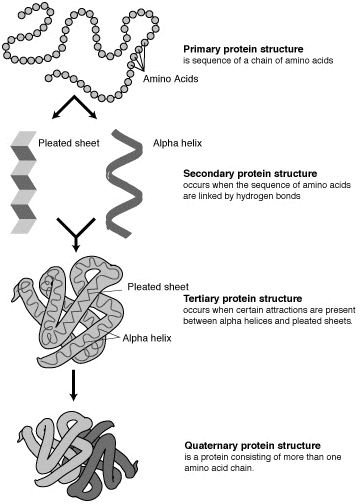Protein Structure. Primary, Secondary, Tertiary and Quaternary Structure of Proteins
Virtually every aspect of cellular activity is dependent on a protein or a set of proteins. Proteins are true agents of biological function and are involved in a great variety of cellular functions including the catalysis of reactions (enzymes), regulation (hormones), transportation, storage, structural function, and protection (immunoglobulin). Each protein is coded by one gene. Proteins are the expression of the genetic information contained in the DNA molecule.
Amino Acids: The Building Blocks of Proteins
From a chemical point of view, proteins are linear (unbranched) polymers of amino acids. Each amino acid becomes attached to another when the amino end (NH2) of one amino acid joins to the carboxyl end (COOH) of another. Amino acids possess an R chain (R for radical) and a hydrogen atom and all are attached to a central carbon atom. It is in the R chain where the variety of amino acids are formed. Differences in the structure of the R chains (sometimes known as the amino acid side chain) result in different amino acid properties.
Protein Structure: Various Levels of Complexity
The molecular structure of a protein is quite complex. However, its study can be simplified by defining the various levels of structural organization.
Primary Structure: The amino acid sequence is the primary structure. With 20 amino acids and the ability to vary the length of the polymer means that the possibilities are endless, hence the great variety of cellular proteins that exist.
Secondary Structure: The polypeptide chain can arrange itself through interaction among amino acids R chains and hydrogen bonds. Here, proteins can assume two conformational structures known as alpha-helix and beta-sheets. These conformations are possible because of constraints that the amino acid backbone imposes on the structure.
Tertiary Structure: A protein bends and folds according to the main amino acid chain. These bends and folds determine a three-dimensional shape or structure known as the tertiary structure. The tertiary structure determines the biological function of the protein(in multi polymeric protein —see next level of structure—, it is the quaternary structure that determines function). A protein must fold into a three dimensional structure for it to function correctly.
Quaternary Structure: There is one more level of complexity within the conformation of proteins. Many proteins are formed by more than one polypeptide chain joined together by covalent bonds. In this case each polypeptide chain is referred to as a subunit. The structure formed by the interaction of different subunits is called the quaternary structure of proteins. In proteins with more than one subunit it is the quaternary structure that determines biological function.
The Importance of the Primary Structure
All the structural levels of a protein (secondary, tertiary and quaternary) are ultimately determined by the primary structure because all the information needed for the molecule to achieve its conformation is imprinted within the primary structure. It is this polypeptide chain (and its components) that determines where the proteins bend, fold, and where they can link to another polymer chain.
Sources:
Garret, R., and Grisham, H. 1995. Biochemistry. Saunders College Publishing.
Voet, D., and Voet, J. 2000. Biochemistry. John Wiley and Sons. 2nd ed..
